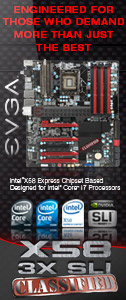«Previous Page 1 2 3 4 5 6 7 -View All- Next Page»
Test Kit
Hardware
- Asus Sabertooth 55i motherboard
- Intel i3 530 retail processor clocked at 3.6ghz (18×200)
- ATI Asus 5770 CuCore 1024mb
- Western Digital 500GB SATA-II hard drive
- Generic DVDRW SATA unit
- OCZ Stealth Stream 400W PSU
- G.Skill RipJaw 2000mhz 1.6v (2×2gb) cl9-9-9-27
- G.Skill ECO 1600mhz 1.35v (2×2gb) cl8-8-8-24
- G.Skill PIS 2000mhz 1.65v (2x2gb) cl6-9-6-24
Software
- Windows Vista Home Premium 64bit
- Intel system drivers
- ATI CCC with 10.3 driver release
Testing Software
- Sisoftware Sandra 2009
- Everest
- WinRar Compression Utility
- cpu-z
Testing
As you may be aware, memory pricing varies across the board from manufacturer to manufacturer. Kits with low timings and higher frequencies are generally considerably more costly than kits that ship with more modest frequencies and less tight timings. The G.Skill PI series of memory kits fall straight at the top of the ddr3 range sporting a blisteringly quick latency set of 6-9-6-24 and speeds of 2000MHZ. From this alone it is easy to see why there is such a fuss where this kit is concerned. At just 1.65volts the PIS range of i3/i5/i7 memory kits falls right at the top end of what is allowed in the intel spec. With this voltage comes little in the means of overclocking where over volting is concerned.
For comparison purposes a 1.60volt rated 2000mhz G.Skill ECO kit has been selected to represent mainstream whilst a set of G.Skill RipJaw 2000mhz cl9 modules has also been selected to show any difference between the two kits where value per performance is concerned.
Everest
 As you can see from the above results, the drop in latency has had a positive effect on bandwidth and latency however the premium over the RipJaw kit certainly is not worth it where day to day use is concerned.
As you can see from the above results, the drop in latency has had a positive effect on bandwidth and latency however the premium over the RipJaw kit certainly is not worth it where day to day use is concerned.
Sisoft Sandra Lite 2010c
 Looking over the Sisoft Sandra results draws a similar conclusion to that of the everest results. So far the low latency is not showing too much of a performance improvement over the more relaxed cl9 of the RipJaws.
Looking over the Sisoft Sandra results draws a similar conclusion to that of the everest results. So far the low latency is not showing too much of a performance improvement over the more relaxed cl9 of the RipJaws.
WinRar File Encryption and Compression
Looking over the File Compression and Encryption tests shows a slightly difference story. Here you can see that the latency drop coupled with the high frequency has shown some positive results shaving a couple of seconds off of each scenario. If you as a user should perform many tasks such as this then you may be on to a winner. Again, it is debatable whether or not this slight drop in time and performance increase is worth the premium paid.






